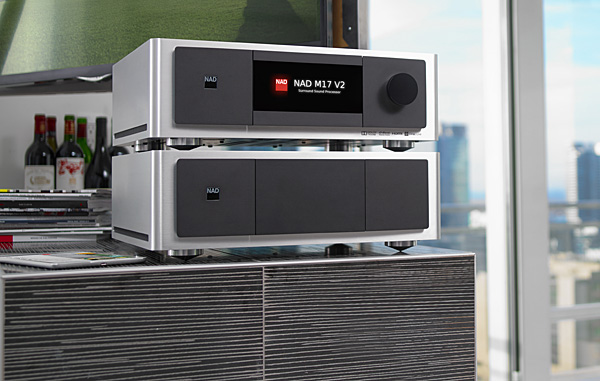NAD M17 V2 Surround Preamp/Processor Review Page 3
Dirac Live
Unlike some of its Room EQ competition, Dirac Live adjusts for both amplitude and phase. It does all of its calculations in your attached computer, and the results are then stored in the NAD, which can hold up to three Dirac Live setups. You can simply use Dirac's own target curve (sloping down gradually from bass to treble—a curve many experts recommend) or create your own. Since the M17 V2 comes with the Dirac Live Pro version, you can also run the EQ full-range or limit it to the bass (below, say, 400Hz, where most serious room problems typically reside).
I ran into difficulties configuring Dirac on the NAD with my Wi-Fi setup. The problems appeared to stem from my router plus the small, relatively weak antenna in the M17 V2's dongle. The manual wasn't particularly helpful here, but additional tech support from NAD and a hard-wired Ethernet connection between the router and the M17 V2 let me get Dirac working.
Before engaging Dirac Live you must first set up the configuration, including the crossover for any intended subwoofer or subwoofers. Dirac will then EQ the sub to a relatively high frequency (around 250Hz) and next engage the low-pass filter you've selected. In my system the top end roll-off of the EQ'ed sub began at a much lower frequency than I anticipated, likely due to a dip in my setup's subwoofer-room response just below 100Hz, one for which Dirac wouldn't entirely compensate (the amount of gain Dirac will engage for any given dip is limited to keep it from overdriving the speaker being equalized). But the subwoofer result actually blended well with the EQ on the main speakers.

After you engage Dirac you're locked out of the individual channel level and distance controls. But you'll still have access to the trim controls on the remote for surround, center, and subwoofer levels, plus the tone controls. All of these may reset to zero when you power down the unit, or select another input, depending on how you've set up the presets. I performed a Dirac setup for all channels, averaging seven microphone positions, and then used Dirac's target curve modified with a slight boost to frequencies below 100Hz.
I next confirmed the results using a mic/measuring software package (Omnimic from Parts Express) to check the results independent of those shown by the Dirac software, using 1/6th octave smoothing. The latter crosscheck isn't mandatory, but it allowed me to manually tweak the tone controls and the subwoofer level, post EQ, with confidence that I wasn't seriously skewing the Dirac results. But since the tweaks I made to these controls for the best overall results were different for both the Dirac and non-Dirac options, and these two modes also differed in volume level, a quick Dirac/non-Dirac A/B comparison wasn't possible.
The benefits of Dirac were clear in both stereo and surround listening. For both I used a stacked pair of KEF Kube12b subs (substituted for the Revel sub used in the earlier, non-Dirac auditioning). Dirac cleaned up the bottom end and delivered a tighter response. It improved imaging by better matching the responses of the left and right speakers and provided a more uniform balance between the fronts and surrounds as well. Voices in the center channel were also more natural, with less sibilance.
I was less certain about the top end. The Monitor Audio Silver 10s that anchor the front of my system are a little sparkly—something I've become accustomed to and like. Dirac flattened the top end out a bit. The EQ'ed result was helped by a boost in the NAD's treble control, one that did not produce a visible top-end peak in the Omnimic-measured curves. After that I had no complaints. On the contrary, I loved what I heard.
Once you become familiar with Dirac Live, there's an almost infinite variety of possible modifications to be made to the Dirac target curve while still remaining in the ballpark of reasonable accuracy. And while a dealer should be able to get you up and running, only by extensive experimentation on your own can you arrive at the best Dirac Live result for you. To do that you'll have to climb a fairly steep learning curve, but it's worth it doing.
Conclusion
Is there a better-sounding preamp-processor than the NAD Masters series M17 V2? For the same money, I doubt it. While I didn't perform a direct A/B comparison with my resident Marantz AV8805, there were times when I thought I heard things from the NAD on familiar material that I hadn't heard before. The Marantz remains a superb piece, with a bit less imposing ergonomics, and it does cost 33 percent less than the NAD. But make no mistake, the M17 V2 has worked its way onto my want list and comes highly recommended for its flexibility and sound quality.




























































